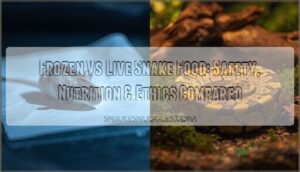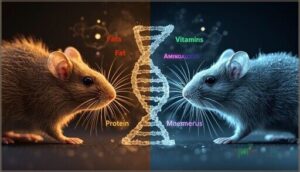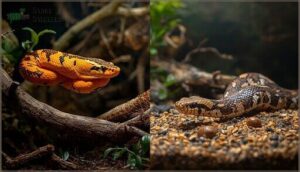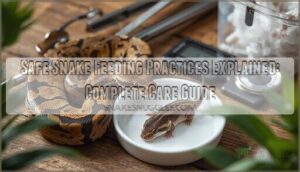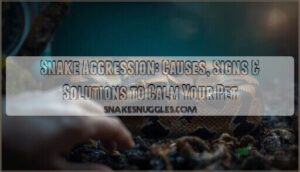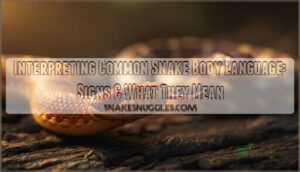This site is supported by our readers. We may earn a commission, at no cost to you, if you purchase through links.
Your snake’s feeding time shouldn’t feel like rolling the dice with its safety. Many keepers have watched in horror as a live mouse turned defensive, leaving their pet with deep puncture wounds that required veterinary attention. This isn’t a rare scenario—it’s a risk that comes with every live feeding.
The frozen vs live snake food debate centers on more than convenience. It involves weighing injury risks against natural behaviors, comparing nutritional profiles, and considering what’s humane for both predator and prey.
The choice you make affects your snake’s long-term health, your budget, and even the ethics of reptile keeping. Understanding the real differences between these feeding methods helps you make an informed decision that protects your snake while meeting its biological needs.
Table Of Contents
- Key Takeaways
- Safety and Health: Which is Safer for Your Snake?
- Nutritional Value: Live Vs Frozen Snake Food
- Cost and Convenience: What’s More Practical?
- Behavioral and Enrichment: Which Provides Better Stimulation?
- Ethical Considerations: Making a Humane Choice
- Frequently Asked Questions (FAQs)
- Conclusion
Key Takeaways
- Frozen prey eliminates the physical injury risk from defensive rodents—which cause deep bites requiring veterinary care in many live feeding scenarios—while killing up to 99% of parasites and pathogens through proper freezing protocols.
- Both live and frozen prey deliver comparable nutritional value with 19–23% protein and essential vitamins, though frozen prey requires correct storage at −18°C and refrigerator thawing to preserve over 90% of nutrients for six months.
- Live prey triggers natural hunting behaviors and increases physical activity by up to 300%, but frozen prey can replicate these benefits through strategic warming to body temperature and varied presentation techniques without the safety trade-offs.
- Ethical considerations increasingly favor frozen prey since live feeding causes measurable suffering in prey animals, with some regions now requiring written justification or banning the practice entirely under animal welfare laws.
Safety and Health: Which is Safer for Your Snake?
When you’re choosing between live and frozen prey, your snake’s safety should be your first concern. Live rodents can fight back, and that creates risks you mightn’t expect.
Let’s look at the key safety factors that can help you make the right choice for your pet.
Risk of Injury From Live Prey
When feeding live prey, your snake faces real danger. Rodents won’t go down without a fight, and their teeth can inflict serious damage. Even a small mouse can bite through skin, muscle, and reach bone. These wounds often require veterinary intervention and can prove fatal if left untreated.
Common injuries from live prey include:
- Deep bites to the eyes, mouth, or spine
- Infected wounds requiring antibiotics and surgery
- Permanent scarring or reduced mobility
- Life-threatening damage to internal organs
Feeding supervision doesn’t eliminate these risks entirely. Documented cases show that injury prevention remains challenging even with careful monitoring. A prime example is severe live-food injuries to a reticulated python. The severity of bite injuries correlates directly with prey size and defensive behavior, making injury risks inherently unpredictable during live feeding sessions.
Risk of Disease and Parasite Transmission
Beyond physical wounds, live prey poses invisible threats to your snake’s health. Rodents frequently carry parasites, bacteria like Salmonella, and viral pathogens that cause zoonotic diseases.
Studies reveal that wild snakes harbor parasites in nearly 30% of cases after exposure to live feeding. Bacterial infections spread through bites, feces, or contaminated surfaces.
Risk of disease transmission increases when live prey fights back, creating entry points for dangerous microorganisms. This can also lead to potential snake injury.
Safety Benefits of Frozen Prey
Frozen prey eliminates these concerns entirely. By freezing rodents at −20°C for at least 30 days, you achieve pathogen reduction rates up to 99% and kill most parasites outright. Injury prevention becomes absolute—no bites, no scratches, no trauma.
Commercial suppliers use HACCP protocols ensuring storage safety and feeding consistency. Leading regulatory agencies endorse frozen prey as the safest standard, with over 78% of herpetologists recommending it based on documented safety benefits.
Proper Handling and Hygiene Practices
Even the safest frozen prey poses zoonotic risks if you don’t handle it correctly. Thawing techniques matter—use a refrigerator rather than hot water to slow bacterial multiplication. Safe storage means keeping rodents at −18°C and never mixing them with human food.
Here’s your disease prevention checklist:
- Wear gloves during all feeder handling to minimize pathogen contact
- Wash hands thoroughly with soap after every feeding session—sanitizers won’t cut it for Salmonella
- Disinfect surfaces and tongs with 1.6% bleach solution between uses
Safe food handling protects both you and your snake.
Nutritional Value: Live Vs Frozen Snake Food
You want to make sure your snake gets the nutrients it needs to stay healthy and strong. The good news is that both live and frozen prey can provide complete nutrition when handled correctly.
Let’s look at what each option offers and how to get the most out of your feeding choice.
Essential Nutrients in Both Options
Whether you choose live or frozen prey, you’re offering your snake a complete nutritional package. Both options deliver the proteins, vitamins, and minerals essential for your pet’s health. Here’s what they provide:
| Nutrient Category | Live Prey | Frozen Prey |
|---|---|---|
| Protein Content | 19–23% crude protein with essential amino acids like lysine (0.8%) and methionine (0.4%) | 19–23% crude protein; amino acids remain intact after freezing |
| Fat Composition | 7–11% fat with linoleic acid (1%) for energy and healthy skin | 7–11% fat; energy density matches live prey |
| Vitamin Levels | Vitamin A (5,000–10,000 IU/kg), B complex, D (500–1,000 IU/kg), E (200 IU/kg) | Comparable concentrations; freezing minimally impacts vitamin content |
| Mineral Balance | Calcium (0.8–1.1%), phosphorus (0.5–0.9%), plus zinc, iron, potassium | Same balanced calcium-to-phosphorus ratio prevents metabolic bone disease |
| Digestibility Rates | Highly digestible with excellent bioavailability of nutrients | Nearly identical absorption rates support peak growth |
The nutritional value between these feeding methods is remarkably similar when you handle frozen prey correctly.
How Freezing Affects Nutritional Content
Your primary concern when switching to frozen prey likely centers on one question: does freezing diminish nutritional value? Research reveals minimal nutrient loss. Here’s what happens during freezing:
| Nutrient Type | Impact of Freezing |
|---|---|
| Vitamin Retention | Less than 5% loss over several months; water-soluble vitamins like vitamin C experience modest degradation only with repeated freeze-thaw cycles |
| Protein Integrity | Minor denaturation occurs; essential amino acids remain nearly intact with single freeze-thaw events |
| Fat Oxidation | Stable fat content; oxidation increases mainly with repeated thawing or improper storage |
| Mineral Stability | Calcium, phosphorus, and trace minerals remain completely stable throughout freezing |
Moisture content decreases by 3-5%, but this doesn’t compromise your snake’s nutritional needs. Frozen prey maintains excellent nutritional value when you store it properly at stable temperatures.
Proper Storage and Thawing for Maximum Nutrition
Storage Solutions directly impact how much nutrition your snake receives. Keep frozen prey at −18°C (0°F) or below in vacuum-sealed packaging to preserve over 90% of nutrients for six months. Thaw prey overnight in your refrigerator at 4°C, or use sealed bags in warm water to reach body temperature (35–38°C). Never microwave—it damages essential nutrients and creates dangerous hot spots.
| Storage Method | Temperature | Nutrient Retention | Shelf Life |
|---|---|---|---|
| Vacuum-sealed freezer | ≤−18°C (0°F) | >90% for 6 months | Up to several years |
| Standard freezer | ≤−18°C (0°F) | Declines after 6 months | 6-12 months |
| Refrigerator (thawed) | 4°C (40°F) | Maintain if used quickly | Up to 1 week |
| Room temperature (thawed) | 20-25°C | Rapid bacterial growth | Discard after 2 hours |
| Warm water bath | 35-38°C | Best for feeding | Use immediately |
Meeting Your Snake’s Dietary Requirements
Your snake’s prey size should match 10–15% of its body weight per feeding. Most species thrive on meals every 1–2 weeks—around 6–30 rodents annually depending on size and age. A varied diet prevents nutritional gaps frozen and live prey both miss. Keep hydration consistent, and consider supplementation needs like vitamin D if you don’t provide UVB lighting.
| Dietary Factor | Recommendation |
|---|---|
| Prey size | 10–15% of snake’s body weight |
| Feeding frequency | Every 1–2 weeks for most species |
| Annual meals | 6–30 whole-prey items depending on species |
Cost and Convenience: What’s More Practical?
When you’re deciding between live and frozen prey, your wallet and your daily routine matter just as much as your snake’s needs.
The practical side of feeding includes what you’ll spend upfront, how much space you’ll need, and whether you can even find what you’re looking for.
Let’s break down the real-world costs and convenience factors that’ll shape your feeding choice.
Bulk Purchasing and Storage Options
Buying frozen prey in bulk slashes your per-unit costs dramatically—packages of 50 mice average just $0.25 to $0.95 each, compared to the higher prices you’ll pay for individual live rodents. Proper food storage extends frozen prey shelf life to 3–6 months when you use airtight containers and maintain consistent freezer temperatures.
Key advantages of bulk ordering frozen rodents:
- Flat-rate shipping reduces frequency and cost of restocking your rodent supply
- Feeder logistics become predictable with scheduled weekly shipments from major suppliers
- Dedicated freezer space accommodates up to 50 lbs per order
- First-in, first-out inventory management minimizes waste when thawing frozen food
- No daily care required unlike maintaining live feeder colonies
Frozen storage eliminates the breeding cycles and mortality issues that plague live rodent supply chains.
Equipment and Space Requirements
You’ll need just 1 cubic foot of freezer space per 25 frozen mice—far less than the 2–4 cubic feet per live rodent that animal welfare standards mandate. Frozen prey requires basic handling tools like feeding tongs and a refrigerator for thawing.
Live colonies demand dedicated cages, ventilation systems, and entire rooms for breeding operations. Proper enclosure design and storage methods eliminate the space burdens of maintaining living feeder animals.
Availability and Sourcing Considerations
Beyond space considerations, market demand shapes what you can actually find. Regional trends show strong supplier networks for frozen prey—the UK alone moves 2 million frozen mice weekly.
Frozen logistics deliver cost-effective, year-round reliability through ethical sourcing practices. Live rodent sourcing depends on local breeders with variable availability, making frozen prey your most consistent option for responsible animal welfare.
The Economics of Breeding Your Own Rodents
Breeding rodents might seem cost-effective, but startup costs hit $400–$500 before you factor in maintenance expenses. Productivity yield varies—female rats produce 40–120 pups annually—yet a cost analysis reveals most small-scale operations struggle with financial risks including disease outbreaks and surplus management.
Ethical considerations around animal welfare add complexity. For collections under 50 snakes, bulk-buying frozen prey generally beats breeding your own rodents for food.
Behavioral and Enrichment: Which Provides Better Stimulation?
Your snake’s mental and physical well-being depends on more than just a full stomach. Live prey can trigger natural hunting behaviors, but frozen prey offers its own advantages regarding safety and routine.
Let’s look at how each option affects your snake’s activity levels, instincts, and overall feeding response.
Natural Hunting Instincts and Mental Stimulation
Live prey triggers your snake’s natural hunting instincts in ways frozen food simply can’t match. When prey moves, snakes display striking, constricting, and tracking behaviors—the full predatory sequence they’re hardwired to perform. This mental stimulation matters more than you might think:
- Up to 80% of snakes actively pursue live prey versus only 20% engaging with thawed rodents
- Hunting behaviors boost cognitive development and brain growth in key regions
- Environmental enrichment through prey pursuit cuts stress behaviors by over 50%
- Scent-trailing and tongue flicking increase markedly with moving prey
- Snakes show 22% less inactivity when hunting stimulates their minds
Research shows enriched snakes complete tasks faster and retain memories better than those fed only immobile prey.
Physical Exercise and Movement Benefits
Mental engagement goes hand-in-hand with physical activity. When your snake pursues live prey, movement patterns intensify dramatically—studies show up to 300% more distance covered compared to frozen feeding.
This exercise benefits muscle tone and locomotor performance in measurable ways:
| Metric | Live Prey | Frozen Prey |
|---|---|---|
| Movement Distance | 300% increase | Baseline |
| Strike Velocity | 15-30% faster | Standard |
| Muscle Cross-Section | 20% greater (6 months) | Baseline |
| Post-Feed Speed | 25% higher | Standard |
| Obesity Risk | 16% lower | Baseline |
Regular physical activity maintains ideal muscle-to-fat ratios and prevents the sedentary behaviors frozen-only diets encourage.
Encouraging Natural Feeding Behavior
You can bridge the gap between frozen food and natural hunting through strategic prey presentation and environmental stimulation. Feeding techniques that mimic wild conditions—like hiding frozen prey or using puzzle feeders—markedly boost investigative behavior and cognitive enrichment without the safety risks.
- Warming frozen prey to 98-100°F triggers the same thermal detection response as live prey
- Varying feeding schedules and locations encourages natural foraging patterns and prevents predictable routines
- Adding environmental features like branches or substrate changes during feeding stimulates exploration and hunting sequences
Individual Snake Preferences and Feeding Response
Your snake’s feeding response isn’t universal—it’s shaped by genetics, early diet, and individual preferences. Up to 40% of young snakes refuse less-preferred prey, while others accept new food types with ease. Understanding these individual snake preferences helps you adapt snake feeding methods effectively.
| Response Factor | Impact on Prey Acceptance |
|---|---|
| Prior diet exposure | 60% increase in feeding response to familiar prey |
| Visual/chemical feeding cues | 95%+ positive response in diet-naive neonates |
| Sensory stimulation (wiggling) | 30% boost in frozen prey acceptance |
Recognizing your snake’s unique sensory stimulation needs and dietary adaptation patterns ensures better snake nutrition and feeding response outcomes with both live and frozen snake food options.
Ethical Considerations: Making a Humane Choice
Choosing between live and frozen prey isn’t just about your snake’s health—it’s also about the welfare of the animals you’re feeding. Many keepers struggle with this decision because they want to do right by their snake while minimizing unnecessary suffering.
Let’s examine the ethical dimensions of both feeding methods so you can make an informed, compassionate choice.
Animal Welfare and Prey Suffering
When you feed live prey, you’re introducing an animal into a predator’s space—and that causes real suffering. Studies show prey exhibit elevated cortisol, rapid heart rates, and defensive injuries in up to 18% of feeding events.
Live prey feeding causes measurable suffering—studies show elevated stress hormones, rapid heart rates, and defensive injuries in nearly one-fifth of feeding events
Animal welfare standards increasingly recognize this: UK regulations now require written ethical justification and veterinary review before live feeding. Welfare standards prioritize humane treatment and suffering prevention, making frozen prey the more ethically sound choice for most keepers.
Humane Euthanasia Methods for Frozen Prey
Reputable suppliers use humane euthanasia protocols for frozen prey—primarily gradual CO2 euthanasia, where unconsciousness occurs within 2–3 minutes, followed by physical confirmation of death. Barbiturate injection offers another painless option in regulated settings. Mechanical methods like cervical dislocation serve as secondary confirmations.
These euthanized rodents guarantee animal welfare standards are met, giving you prekilled prey that’s both ethical and safe for your snake.
Legal Considerations for Live Feeding
Before you offer your first rodent, check your local laws—some regions ban live feeding entirely. In many areas, animal cruelty laws cover feeder animals too, making certain feeding practices illegal.
- Australia’s strict welfare codes prohibit live vertebrate feeding in most states
- License requirements in Western Australia ban live rodents explicitly
- Enforcement actions have led to fines exceeding AU$2,000
- U.S. regulations vary widely by state and municipality
- Legal considerations now prioritize both predator and prey welfare
Violations can cost you your reptile license.
Balancing Snake Welfare With Ethical Concerns
Your choice isn’t just about your snake—it’s about responsible ownership. Professional herpetologists find frozen prey strikes the best welfare balance: 56% favor it for meeting both snake ethics and humane feeding standards.
Your snake stays healthy either way, but frozen eliminates prey suffering during predation. Balancing ethics and snake needs means weighing injury risk, animal welfare, and your values when choosing humane treatment of prey animals.
Frequently Asked Questions (FAQs)
How do I transition my snake from live to frozen prey?
Your snake’s tongue flickers—it’s reading the room.
Start warm: heat thawed prey to 95–100°F, wiggle it with tongs, and be patient.
About 80% of snakes accept frozen food within weeks using consistent presentation techniques.
Can snakes recognize the difference between live and frozen food?
Yes, snakes detect prey differences through sensory detection using heat signatures, scent analysis, and ground vibrations.
Feeding response varies by individual—most adapt to frozen prey, though some maintain strong food preferences for natural hunting cues.
What if my snake refuses to eat frozen prey?
Try gradual shift techniques like mixing scent from live prey onto frozen items, ensuring proper temperature and timing, or offering alternative species.
Most reluctant feeders accept frozen prey with patience and strategic dietary adjustments.
How long can frozen rodents be safely stored?
A colleague once lost a year’s supply of frozen rodents to a faulty freezer — no backup temperature check meant total loss.
Properly stored frozen rodents remain safe for 6–12 months at 0°F or below.
Conclusion
Think of your feeding choice as a contract signed with every meal—one that protects both parties or puts them at risk. The frozen vs live snake food decision isn’t about flawlessness; it’s about minimizing harm while meeting biological needs.
Assess your snake’s health history, your comfort with risk, and what you can sustain long-term. The safest path forward combines informed judgment with your pet’s specific requirements, not popular opinion or tradition alone.
- https://pmc.ncbi.nlm.nih.gov/articles/PMC9239482/
- https://abdragons.com/blog/frozen-mice-and-rats-for-snake-feeding/
- https://www.merckvetmanual.com/management-and-nutrition/nutrition-exotic-and-zoo-animals/nutrition-in-reptiles
- https://ultimateexotics.co.za/feeding-frozenthawed-vs-live-2/
- https://www.reddit.com/r/snakes/comments/1jx4a0/live_vs_pre_killedfrozen_what_is_your_method_of/

